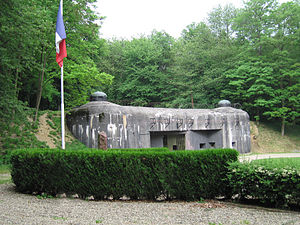Maginot line
| Maginot Line | |
|---|---|
| Ligne Maginot | |
| Eastern France | |

The entrance to Ouvrage Schoenenbourg along the Maginot Line in Alsace
|
|
| Type | Defensive line |
| Site information | |
| Controlled by | France |
| Open to the public |
Yes |
| Condition | Mostly intact, through the preservation of the French Government |
| Site history | |
| Built | 1929–1938 |
| Built by |
Paul Painlevé, Colonel Tricaud
|
| In use | 1935–1969 |
| Materials | Concrete, steel, iron |
| Battles/wars |
|
Paul Painlevé, Colonel Tricaud
The Maginot Line (French: Ligne Maginot, IPA: [liɲ maʒino]), named after the French Minister of War André Maginot, was a line of concrete fortifications, obstacles and weapon installations that France constructed on the French side of its borders with Switzerland, Germany and Luxembourg during the 1930s. The line did not extend through to the English Channel because the French military did not want to offend Belgium given its policy of neutrality. The line was a response to France's experience in World War I and was constructed during the run-up to World War II, shortly after the Locarno Conference that gave rise to a fanciful and optimistic "Locarno spirit".
The French established the fortification to give their army time to mobilize in the event of attack, and allow French forces to move into Belgium for a decisive confrontation with Germany. The success of static, defensive combat in World War I was a key influence on French thinking. French military experts extolled the Maginot Line as a work of genius, believing it would prevent any further invasions from the east.
The Maginot Line was impervious to most forms of attack, including aerial bombings and tank fire, and had underground railways as a backup; it also had state-of-the-art living conditions for garrisoned troops, supplying air conditioning and eating areas for their comfort. Nevertheless, it proved strategically ineffective during the Battle of France. Instead of attacking directly, the Germans invaded through the Low Countries, bypassing the Line to the north. French and British officers had anticipated this: when Germany invaded the Netherlands and Belgium, they carried out plans to form an aggressive front that cut across Belgium and connected to the Maginot Line. However, the French line was weak near the Ardennes forest, a region whose rough terrain they considered unlikely for the Germans to traverse. The German Army took advantage of this weak point to split the French–British defensive front. The Allied forces to the north were forced to evacuate at Dunkirk, leaving the forces to the south unable to mount an effective resistance to the German invasion of France.
...
Wikipedia
